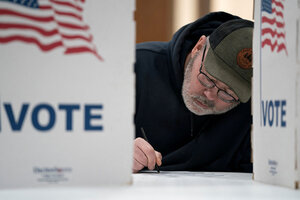Trump hammers on ‘migrant crime.’ The reality: It’s not rampant, but a real concern.
| Denver
In the closing stretch of the election, former President Donald Trump continues to emphasize claims of “migrant crime.” On Friday, he spoke in Aurora, Colorado, a city he charges is overrun by a Venezuelan gang. The Republican mayor has said such concerns have been “grossly exaggerated.”
Immigration is a top voter concern, polls show, and Mr. Trump has doubled down on assertions that unauthorized-migrant criminals are endangering U.S. citizens. He’s also raised the profile of murder cases, such as that of Laken Riley, in which the suspects are immigrants who authorities say entered the country illegally.
For her part, Vice President Kamala Harris has largely avoided public discussion of historically high unauthorized migrant encounters with the Border Patrol under the Biden-Harris administration. She has called for more border security resources from Congress and blames Mr. Trump for thwarting a related bipartisan bill for political reasons.
In response to Mr. Trump’s migrant-crime claims, media reports often cite research finding that immigrants – including those who are unauthorized – do not commit crimes at higher rates than U.S. citizens. Some of Mr. Trump’s backers are skeptical of that research.
We lay out some recent high-profile crimes, and examine how research on immigrant crime rates is conducted.
What recent crimes have officials linked to unauthorized-immigrant suspects?
Here’s a sample of high-profile cases that have captured attention in Congress, Trump rallies, and national headlines this year.
- Laken Riley. This February, police found the college-age nursing student’s body in the woods of the University of Georgia campus in Athens.
Jose Ibarra, a Venezuelan national indicted for murder, kidnapping, and other charges, has pleaded not guilty. Mr. Ibarra was apprehended by federal authorities in 2022 after unlawfully entering the United States near El Paso, Texas, according to an Immigration and Customs Enforcement (ICE) spokesperson. He was then paroled into the country and released for further processing.
Attorneys for the defendant did not respond to interview requests. The Georgia trial is expected to start next month.
- Rachel Morin. In August 2023, the Maryland mother of five was found dead by a volunteer searcher along a trail in Hartford County.
A grand jury indicted Victor Martinez-Hernandez, a national of El Salvador, with charges that include murder and rape. According to an ICE spokesperson, he attempted to enter the U.S. illegally four times in early 2023, and was repeatedly expelled by the Border Patrol under a pandemic policy.
Through a spokesperson, attorneys for the defendant declined to comment. The trial is expected to start next year.
- Jocelyn Nungaray. Houston police found the 12-year-old dead in a creek in June.
A grand jury indicted Johan Martinez-Rangel and Franklin Pena, both Venezuelan nationals, on murder charges. Both men were apprehended by the Border Patrol near El Paso this year, after entering the U.S. illegally, according to an ICE spokesperson. Both were released into the U.S. with a notice to appear in immigration court.
Mr. Pena is a “documented Tren de Aragua gang member,” according to ICE. The Biden administration has labeled the Venezuelan gang a transnational criminal organization. Attorneys for Mr. Pena did not respond to interview requests. Mr. Martinez-Rangel declined to comment through his legal counsel. A trial start date hasn’t yet been announced.
Do unauthorized immigrants commit more crimes than U.S. citizens?
Overall, research points to no hard evidence that unauthorized immigrants commit crimes at higher rates than U.S. citizens. That said, data collection is limited.
Charis Kubrin co-wrote “Immigration and Crime: Taking Stock,” a review of dozens of studies dating back to the early 1900s. “If we take a very global look at what the studies say, what we know is that immigrants themselves offend at a lower rate than their native-born peers,” says Professor Kubrin, professor of criminology at the University of California, Irvine. The studies found that crime rates in cities generally aren’t impacted by immigration.
Among the studies she reviewed, the majority focused on immigrants overall. A smaller number looked at unauthorized immigrants and relied on population estimates from the government and research groups.
Research on the unauthorized population is limited by scarce data collection on its size and related crime trends. The government and several researchers estimate 11 million unauthorized immigrants are living in the U.S., though it’s unclear how recent arrivals may impact these numbers. Experts also raise the likelihood of underreported crimes in unauthorized-immigrant communities. Mistrust of law enforcement and fear of deportation factor in, they say.
In domestic violence cases, for instance, some victims consider immigration consequences beyond themselves, says attorney Rosie Read. “They don’t want to get their partner deported,” she says, though they “want the abuse to stop.”
Another research challenge: Police rarely collect and report immigration status in systematic ways. Texas is an exception. Yet peer-reviewed research conducted in the Lone Star State squares with broader findings.
Between 2012 and 2018, sociologist Michael Light found, unauthorized immigrants in Texas were arrested for felonies at roughly half the rate of American-born citizens.
To compare arrest rates, this study used immigration-status data that Texas receives from the Department of Homeland Security. For the unauthorized population in Texas as a whole, the study relied on data from the Center for Migration Studies of New York, a think tank that promotes “the dignity and rights of migrants.” The think tank’s data is based on census estimates.
Some critics question the accuracy of how such studies determine all who are “unauthorized.” Beyond limitations in research, Jessica Vaughan at the Center for Immigration Studies finds the broader debate “pointless.”
Even if unauthorized immigrants are less likely to commit crimes than U.S. citizens, they aren’t supposed to be here in the first place, says Ms. Vaughan, director of policy studies at the organization, which supports lower immigration rates.
Families of victims “don’t really care what the crime rate is among all illegal aliens,” she says. “What difference does it make?”
The important policy question to consider is how to “deal with that fraction of the noncitizen population that has committed a crime,” says Ms. Vaughan. If they’re deportable, she says, “How do we make sure that happens?”
Other analysts warn of warped perceptions. Focus on immigrant crime isn’t new, but Mr. Trump’s concentration on the topic and the immediacy of the internet have raised awareness, says David Bier, director of immigration studies at the Cato Institute. The think tank supports expanding and deregulating immigration.
“We’ve seen immigrant crime be a focus of anti-immigration advocacy for a long time,” he says. “Former President Trump raised that issue to a level that’s really unprecedented in its focus.”
Are violent crime rates by unauthorized immigrants going up?
Again, there are no national rates for this group.
For the country overall, violent crime decreased by 3% in 2023 compared with 2022 estimates, reports the FBI. However, FBI crime data comes with caveats, as not all police departments participate each year.
That said, a think tank has drawn similar conclusions around downward-trending crime. Based on data from 39 cities with varied levels of reporting, the Council on Criminal Justice estimates that, as of mid-2024, most violent crimes fell at or below prepandemic levels. Like the FBI, the council excludes immigration status due to inconsistent reporting from law enforcement.
“Until law enforcement agencies make a decision to collect that information ... we’re going to continue to chase these claims,” says Alex Piquero, professor of criminology at the University of Miami. Other researchers have suggested a link between states with large unauthorized-immigrant populations and higher rates of ID theft, but urge further investigation.
Controversy erupted last month over a letter from ICE to Rep. Tony Gonzales, a Republican from Texas. Mr. Gonzales asked the Biden administration to provide him with information on noncitizen criminal convictions and ICE custody.
Mr. Gonzales made public ICE’s response. The agency said that there were more than 600,000 noncitizens with criminal convictions or pending criminal charges – including about 13,000 convicted of homicide – on the agency’s “non-detained docket,” which means they are not in ICE detention.
A Department of Homeland Security spokesperson clarified that the list includes people incarcerated in other detention facilities and it involves those who entered the country over the past 40 years or more. Mr. Trump has seized upon the letter to charge, without evidence, that Ms. Harris admitted 13,000 murderers during her term as vice president.
Immigrant advocates, meanwhile, say that xenophobic rhetoric leads to danger. In New York City, advocates point to an alleged bomb threat last month against a migrant shelter.
“We need our elected officials to stop with the horrible rhetoric and the continual scapegoating of immigrant communities,” says Murad Awawdeh, president of the New York Immigration Coalition. “It’s only putting a target on their back.”
What’s being done to keep communities safe?
Efforts include incentivization of immigrants to report crimes and calls for more local collaboration with federal immigration authorities.
In Wyoming, Ms. Read, the attorney, helps unauthorized immigrants who are victims of crimes apply for certain visas in exchange for aiding investigations. Though securing one can take years, a U visa can lead to a green card.
“When immigrants, authorized or not, are not reporting crimes ... the entire community becomes less safe,” says Ms. Read, legal director of the Wyoming Immigrant Advocacy Project. Congress created the visa in 2000 to “incentivize reporting,” she says.
Advocates for more border security argue that curbing illegal immigration – and increasing deportations – will reduce crime by unauthorized immigrants overall. They also often support dismantling “sanctuary” policies that limit law enforcement collaboration with ICE. The agency calls collaborative custody arrangements with police departments “critical public safety tools,” which also save resources spent on finding suspects at large.
Not all researchers are convinced that such cooperation is effective overall. That includes Professor Kubrin, who calls for more studies about policy impacts on immigrants and their communities – and moving away from a too-narrow focus on crime narratives.
“You don’t hear about the immigrants that come to this country, and are successful, and don’t engage in crime,” she says. “There’s no story there.”
Editor’s note: This article was updated Oct. 11, 2024, the date of its original publication, to reflect that the planned Trump rally in Aurora occurred as scheduled.















